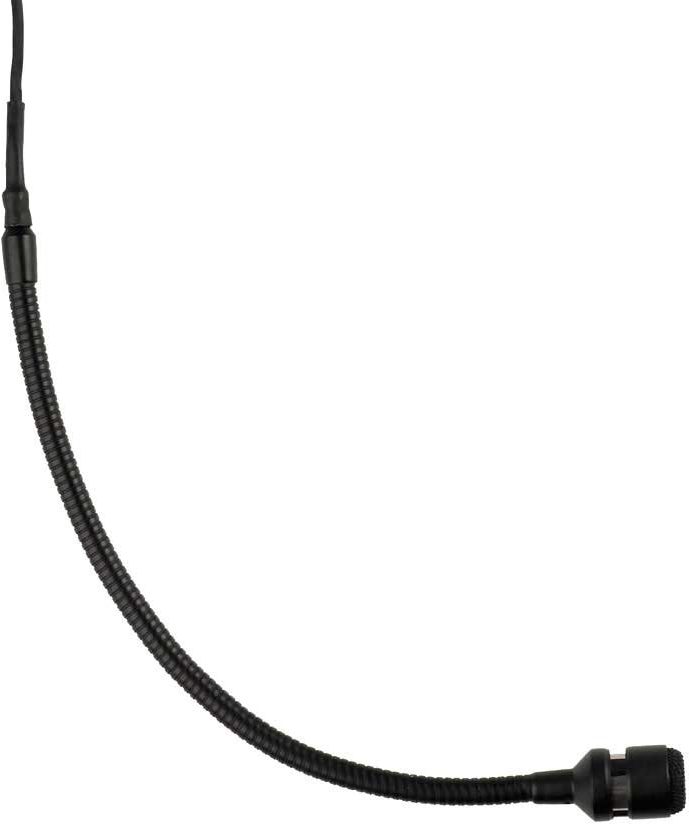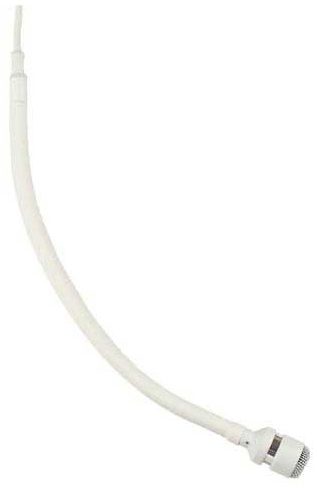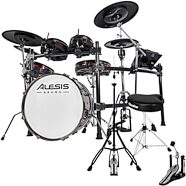CAD CM100 Overhead Choir Microphone
No longer available at zZounds














zZounds Gear Experts Say...
The CAD CM100 is a superior low noise, electret condenser cardioid choir microphone.
Overview
Hanging microphones for unobtrusive sound!
Most microphones on the market today are designed with a specific application in mind. Some are specially tuned for vocal reproduction, and some are built to get drums and amp cabinets to sound their best. In these situations, microphones are placed close to the audio source to isolate the tone. For broader sound reinforcement, hanging microphones help round out the mix from a distance. With professional-quality sound and a slim profile, CAD's CM100 hanging microphones are made to be heard, not seen.
Wide frequency range
The CM100 contains a tiny electret condenser element to bring warmth and character to any live-sound installation. With a frequency range of 40Hz to 20kHz, all the intricate textures in your music come through with presence and clarity. Close-mic'ed mixes are usually tight, but they can also be a bit dry. Add a few CM100's to the stage plot and you can blend in a touch of the natural room ambience. Vocals and instruments will all benefit from the extra richness, and the music will really come to life.
Organic performance microphones
These microphones are also capable of functioning as the primary pickup method for more organic performances. Choirs, orchestras, and handbells can all be difficult to amplify effectively. In many cases, it would require too many microphones to get the proper mix. Hanging microphones provide some separation from the sound source, so you can concentrate on pickup-zones as opposed to individual… read more instruments. Use two CM100's for a stereo mix, or more microphones to group by range. With one microphone getting all the tenors and another aimed at the sopranos, you can effectively EQ each section to highlight their distinct tones.
Cardioid pickup pattern
A unidirectional cardioid pickup pattern limits off-axis sound for accurate aiming control. The CM100's flexible gooseneck lets you focus on the intended source while rejecting floor-monitor or front-of-house speaker output. A small hole in the microphone head accepts monofilament line to hold the gooseneck in place. No feedback loops, only clear, unobtrusive audio. Sound engineers often have the thankless task of balancing a high-quality mix with clean visual appeal. The school- or church-production may sound great, but parents will still complain if all their pictures of little Suzie have a big fat windscreen where her cute little pigtails should be. The CM100's hanging design and gooseneck positioning allows for a clear view of the performers, not the microphones. CM100's are available in black or white to blend into any decor.
Breakout-box for small footprint
The bulk of the electronics are housed in a separate breakout box to preserve the smallest possible footprint. A professional quality 3-pin XLR connection links the box to a mini-XLR plug on the gooseneck. The included 30-foot patch cable gives you plenty of flexibility to hang the microphone wherever it will be most effective. Batteries aren't necessary as the CM100 takes phantom power. If your mixer or microphone preamp doesn't support this feature, you'll need to get an external phantom power supply.
Audience mics for in-ear monitors
Many live-sound engineers are finding ways to reduce stage volume for greater control over the mix. With in-ear monitors, digital guitar processors, and electronic drum sets, it is possible to push all of the sound through the front-of-house mains, with all EQ and volume adjustments made at the board. Many musicians claim their in-ear mix is too sterile, though, and the performance suffers as a result. When used as "audience mics" the CM100 can be sent to the in-ear mix and left out of the mains. This lets the musicians connect with the room, adding the context and color necessary to tighten up an otherwise lifeless performance.
Strict quality control standards
Hanging microphones are most often used in permanent installations, usually out of easy reach. Reliability is very important, because swapping them out can be a chore. CAD's hanging microphones will provide years of trouble-free operation due to their strict manufacturing and design standards. While many competitors outsource their production needs, CAD maintains a U.S. manufacturing facility. This allows their design engineers to supervise and direct every aspect of the production process, for the utmost quality control. In other words, you can set 'em and forget 'em. read less
Most microphones on the market today are designed with a specific application in mind. Some are specially tuned for vocal reproduction, and some are built to get drums and amp cabinets to sound their best. In these situations, microphones are placed close to the audio source to isolate the tone. For broader sound reinforcement, hanging microphones help round out the mix from a distance. With professional-quality sound and a slim profile, CAD's CM100 hanging microphones are made to be heard, not seen.
Wide frequency range
The CM100 contains a tiny electret condenser element to bring warmth and character to any live-sound installation. With a frequency range of 40Hz to 20kHz, all the intricate textures in your music come through with presence and clarity. Close-mic'ed mixes are usually tight, but they can also be a bit dry. Add a few CM100's to the stage plot and you can blend in a touch of the natural room ambience. Vocals and instruments will all benefit from the extra richness, and the music will really come to life.
Organic performance microphones
These microphones are also capable of functioning as the primary pickup method for more organic performances. Choirs, orchestras, and handbells can all be difficult to amplify effectively. In many cases, it would require too many microphones to get the proper mix. Hanging microphones provide some separation from the sound source, so you can concentrate on pickup-zones as opposed to individual… read more instruments. Use two CM100's for a stereo mix, or more microphones to group by range. With one microphone getting all the tenors and another aimed at the sopranos, you can effectively EQ each section to highlight their distinct tones.
Cardioid pickup pattern
A unidirectional cardioid pickup pattern limits off-axis sound for accurate aiming control. The CM100's flexible gooseneck lets you focus on the intended source while rejecting floor-monitor or front-of-house speaker output. A small hole in the microphone head accepts monofilament line to hold the gooseneck in place. No feedback loops, only clear, unobtrusive audio. Sound engineers often have the thankless task of balancing a high-quality mix with clean visual appeal. The school- or church-production may sound great, but parents will still complain if all their pictures of little Suzie have a big fat windscreen where her cute little pigtails should be. The CM100's hanging design and gooseneck positioning allows for a clear view of the performers, not the microphones. CM100's are available in black or white to blend into any decor.
Breakout-box for small footprint
The bulk of the electronics are housed in a separate breakout box to preserve the smallest possible footprint. A professional quality 3-pin XLR connection links the box to a mini-XLR plug on the gooseneck. The included 30-foot patch cable gives you plenty of flexibility to hang the microphone wherever it will be most effective. Batteries aren't necessary as the CM100 takes phantom power. If your mixer or microphone preamp doesn't support this feature, you'll need to get an external phantom power supply.
Audience mics for in-ear monitors
Many live-sound engineers are finding ways to reduce stage volume for greater control over the mix. With in-ear monitors, digital guitar processors, and electronic drum sets, it is possible to push all of the sound through the front-of-house mains, with all EQ and volume adjustments made at the board. Many musicians claim their in-ear mix is too sterile, though, and the performance suffers as a result. When used as "audience mics" the CM100 can be sent to the in-ear mix and left out of the mains. This lets the musicians connect with the room, adding the context and color necessary to tighten up an otherwise lifeless performance.
Strict quality control standards
Hanging microphones are most often used in permanent installations, usually out of easy reach. Reliability is very important, because swapping them out can be a chore. CAD's hanging microphones will provide years of trouble-free operation due to their strict manufacturing and design standards. While many competitors outsource their production needs, CAD maintains a U.S. manufacturing facility. This allows their design engineers to supervise and direct every aspect of the production process, for the utmost quality control. In other words, you can set 'em and forget 'em. read less
Specs
Generating Element: Electret Condenser (Phantom Powered)
Polar Pattern: Unidirectional (Cardioid)
Frequency Response: 40 Hz - 20 kHz
Output Level: -48 dB (0 dB - 1 mW per 10 microbars) Open Circuit
Voltage: -68 dB (0 dB = 1 volt per microbar) 4 mV/Pascal
Impedance: Low (150 ohms nominal)
Dynamic Range: 100 dB
Equivalent Noise Level: Less than 30 dB, A-weighted
Maximum SPL: 130 dB (1% THD, open circuit)
Supply Voltage: 9 - 52 Vdc, positive pins 2 & 3 reverse polarity protected
Current Required: Less than 2.0 mA over operating voltage range
Phasing: Positive Pressure on Diaphragm generates a positive voltage on pin 2 relative to pin 3
Polar Pattern: Unidirectional (Cardioid)
Frequency Response: 40 Hz - 20 kHz
Output Level: -48 dB (0 dB - 1 mW per 10 microbars) Open Circuit
Voltage: -68 dB (0 dB = 1 volt per microbar) 4 mV/Pascal
Impedance: Low (150 ohms nominal)
Dynamic Range: 100 dB
Equivalent Noise Level: Less than 30 dB, A-weighted
Maximum SPL: 130 dB (1% THD, open circuit)
Supply Voltage: 9 - 52 Vdc, positive pins 2 & 3 reverse polarity protected
Current Required: Less than 2.0 mA over operating voltage range
Phasing: Positive Pressure on Diaphragm generates a positive voltage on pin 2 relative to pin 3
CAD Audio's Description
CAD CM100 Choir Microphone
The CM100 microphones have a wide, flat frequency response which provides unsurpassed, natural, transparent sound quality. Their cardioid pickup pattern minimizes annoying feedback when used close to sound reinforcement speakers and monitors, while reducing the pickup of unwanted off-axis sounds.The CM100's electronics are located externally in a housing which also contains the professional 3-pin male XLR connector. The CM100 is attached to this with a 30 ft. cable terminated with a mini 3-pin XLR. The CM100 is finished in durable black urethane paint with a flexible PVC covering over the gooseneck.
The CM100 features a .022 in. diameter hole placed directly behind the microphone head that facilitates the use of monofilament line to inconspicuously fix the position of one or a series of microphones.
About CAD
CAD Professional Microphones, a division of CTI Audio, designs and manufacturers professional microphones in its state-of-the-art USA facility, located in Conneaut, Ohio. An influence in the development of microphone technology over the last decade, the company made its mark bringing distinction to reasonably priced mics, revolutionizing the studio mic market. As the word got around, other manufactures began to follow suit and new competitors entered the marketplace. This is most obvious in the studio condenser arena, where dozens of models have been introduced over the last 2 years. While promising the sound of the revered "vintage" mics, most of these new "classics" are made in the Far East, many in the same factory.
CAD designers have remained focused on the factors that make a great mic sound great: High sensitivity, transparency, precise transient, phase response, wide frequency response, and extremely low self noise. The microphone's capsule must capture the impact, tone, ambience, and nuances of an instrument or voice. CAD's renowned Optema capsules are 24K gold sputtered and hand dampened in CTI's clean room facility. Like only a handful of true microphone manufactures, CAD maintains it own manufacturing facility in the USA. This gives CAD designers control over every aspect of the mic's design, performance, and quality.
CTI Audio's roots go back to the 1930's, when they developed many innovative mic designs, including the T2, possibly the world's first dual tube condenser mic. CAD's celebrated Equitek studio condensers became associated with the explosive project studio market, and a requisite for the sound of the urban music styles of the 90's. When conservative engineers and producers began to discover and demand CAD, the brand became established as a standard. Today, CAD is looked to for their first class design, and for microphones unparalleled in their ability to memorialize the recordings they're used on.
No longer available at zZounds
In most cases, a product is unavailable because it has been discontinued by the manufacturer
This is a carousel with product cards. Use the previous and next buttons to navigate.












